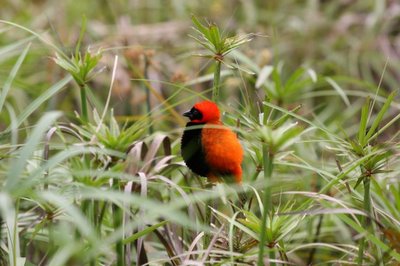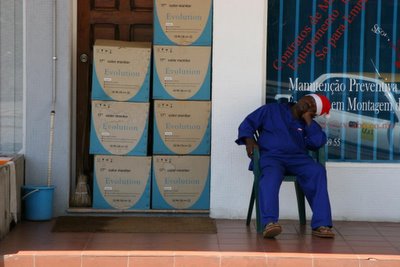Sehlabathebe, Lesotho . . . “Dumela”
The Drakensberg National Park lies on the border of Lesotho, so we decided to make our entry into Lesotho part of the hike and walk in. We spent our last night in ‘the Berg’ camping in a cave watching baboons on the ridge below.
Most of the next day was spent walking to Sehlabathebe, a village in Lesotho. More concerned about the aesthetics of the hiking route than administrative hassles we decided against the route that went via the border post. Instead we hiked from the Drakensburg National Park through the Sehlabathebe National Park in Lesotho, ducking through a barbed wire border fence (guarded by a few random cows) and failing to get our passports stamped on the way.
The people of Lesotho (pronounced “Lee-soo-too”) are called Basotho (plural) or a Masotho (singular) and they speak Sesotho. Sesotho is a fairly tricky as it contains several clicks and other sounds in the place of certain letters. All this confuses most English speakers (including us) to such a degree one suspects it is payback for the numerous idiosyncrasies of the English language. There has to be some punishment for the silent ‘k’.
We met the first of these ingenious people in a bit of a state. We had not showered for longer than I care to admit and we had been walking for most of the day. The distance we had planned to walk that morning was about 6 km, according to the map. What we had not accounted for was the fact that the roads in Lesotho were obviously designed by a sadist whose aim was to make hikers suffer by picking the longest possible route between two points. Six kilometres ‘as the crow flies’ was almost three times that in fact.
Ranting aside, we arrived in Shelabathebe desperately searching for somewhere to stay. The village gave real meaning to the word ‘isolated’ and on arrival it looked like we would be camping at the back of someone’s hut . . . but all was not lost. We found a clean guest house (or perhaps the owner found us) that had hot and cold taps and electric lights. Joy.
This initial joy was somewhat diminished after we checked in and found that despite the taps there was no running water and despite the electric lights switches, lampshades and even globes – there was no electricity. We were not too disheartened. We had a bath with a bucket of water (Phil’s first bucket bath) and found later that there was a generator that was switched on from 7pm to 9pm at night. So we were clean, we had some light and clean sheets. Luxury after several days of camping.
Almost out of food we stocked up at the village store run by two Chinese men (there is probably a good story behind their choice of Sehlabathebe to set up shop but I didn’t manage to get it despite the probing of several locals). The store was stocked full of shelves of soya mince which we found strange. Given the preponderance of cows and the slaughter of a sheep we witnessed earlier in the day, we had the feeling we were unlikely to stumble upon any vegetarians. We were curious, but not curious enough to try it.
We arrived at Sehlabethebe on Saturday afternoon and found (amazingly) that there was a bus that would take us out of the village so we could continue our exploration of Lesotho . . . but (not so amazingly) it did not leave until Monday morning. We spent the next day or so reading and lazing around. Just as we were getting bored we discovered the local pub, a place named ‘Green House Restaurant’ - but with no food. We spent much of Sunday afternoon and evening at the pub where Phil was beaten at pool several times by two 8 year olds and I attempted to tactfully (and with as little lying as possible) fend off queries about my sex life from two local women- a 21 year old who was the Chief’s daughter and a 32 year old teacher.
From both: “Is that your husband?” “Why is he not wearing his ring?” “In our culture we do not have sex before we are married. No sex.” “We are not married. So, no sex.” “Do you have sex with him?” (We all look at Phil)
Me: (Nervous laughter)
The Chief’s daughter:“I would like to try it. But I can’t because of the culture.”
The teacher: “I want to have children but I am scared of sex. I don’t want to have sex.”
Me: (Seeing the opportunity to make a comment confidently) “Well, it will be very difficult to have children then.”
The Chief’s daughter: “I would like to try the sex. But the culture . . . also, I have heard it is painful at first. Do you find it enjoyable?”
Teacher: “Yes, please tell us sister, is it enjoyable?”
Me: (More nervous laughter. Several beseeching looks at Phil to leave his pool game and help me. Ignored by Phil. More nervous laughter.)
And so on . . . until the pub’s generator failed. Saved.
Most of the next day was spent walking to Sehlabathebe, a village in Lesotho. More concerned about the aesthetics of the hiking route than administrative hassles we decided against the route that went via the border post. Instead we hiked from the Drakensburg National Park through the Sehlabathebe National Park in Lesotho, ducking through a barbed wire border fence (guarded by a few random cows) and failing to get our passports stamped on the way.
The people of Lesotho (pronounced “Lee-soo-too”) are called Basotho (plural) or a Masotho (singular) and they speak Sesotho. Sesotho is a fairly tricky as it contains several clicks and other sounds in the place of certain letters. All this confuses most English speakers (including us) to such a degree one suspects it is payback for the numerous idiosyncrasies of the English language. There has to be some punishment for the silent ‘k’.
We met the first of these ingenious people in a bit of a state. We had not showered for longer than I care to admit and we had been walking for most of the day. The distance we had planned to walk that morning was about 6 km, according to the map. What we had not accounted for was the fact that the roads in Lesotho were obviously designed by a sadist whose aim was to make hikers suffer by picking the longest possible route between two points. Six kilometres ‘as the crow flies’ was almost three times that in fact.
Ranting aside, we arrived in Shelabathebe desperately searching for somewhere to stay. The village gave real meaning to the word ‘isolated’ and on arrival it looked like we would be camping at the back of someone’s hut . . . but all was not lost. We found a clean guest house (or perhaps the owner found us) that had hot and cold taps and electric lights. Joy.
This initial joy was somewhat diminished after we checked in and found that despite the taps there was no running water and despite the electric lights switches, lampshades and even globes – there was no electricity. We were not too disheartened. We had a bath with a bucket of water (Phil’s first bucket bath) and found later that there was a generator that was switched on from 7pm to 9pm at night. So we were clean, we had some light and clean sheets. Luxury after several days of camping.
Almost out of food we stocked up at the village store run by two Chinese men (there is probably a good story behind their choice of Sehlabathebe to set up shop but I didn’t manage to get it despite the probing of several locals). The store was stocked full of shelves of soya mince which we found strange. Given the preponderance of cows and the slaughter of a sheep we witnessed earlier in the day, we had the feeling we were unlikely to stumble upon any vegetarians. We were curious, but not curious enough to try it.
We arrived at Sehlabethebe on Saturday afternoon and found (amazingly) that there was a bus that would take us out of the village so we could continue our exploration of Lesotho . . . but (not so amazingly) it did not leave until Monday morning. We spent the next day or so reading and lazing around. Just as we were getting bored we discovered the local pub, a place named ‘Green House Restaurant’ - but with no food. We spent much of Sunday afternoon and evening at the pub where Phil was beaten at pool several times by two 8 year olds and I attempted to tactfully (and with as little lying as possible) fend off queries about my sex life from two local women- a 21 year old who was the Chief’s daughter and a 32 year old teacher.
From both: “Is that your husband?” “Why is he not wearing his ring?” “In our culture we do not have sex before we are married. No sex.” “We are not married. So, no sex.” “Do you have sex with him?” (We all look at Phil)
Me: (Nervous laughter)
The Chief’s daughter:“I would like to try it. But I can’t because of the culture.”
The teacher: “I want to have children but I am scared of sex. I don’t want to have sex.”
Me: (Seeing the opportunity to make a comment confidently) “Well, it will be very difficult to have children then.”
The Chief’s daughter: “I would like to try the sex. But the culture . . . also, I have heard it is painful at first. Do you find it enjoyable?”
Teacher: “Yes, please tell us sister, is it enjoyable?”
Me: (More nervous laughter. Several beseeching looks at Phil to leave his pool game and help me. Ignored by Phil. More nervous laughter.)
And so on . . . until the pub’s generator failed. Saved.









